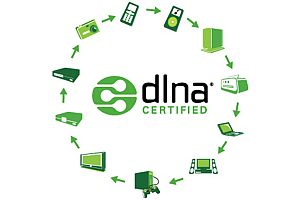As technology advances we’ve noticed a growing trend with manufacturers advertising their wares with an endless list of features, most of which are usually abbreviations, which make it even trickier to understand what the product actually does: HSDPA, Wi-Fi, LED, NFC – the list goes on.
Our Jargon Busted feature aims to break down the barrier between confused customers and the latest technologies, explaining exactly what that abbreviation stands for, or what that feature actually does. This week we’re taking a look at DLNA, so what exactly is DLNA?
Digital Living Network Alliance
DLNA stands for Digital Living Network Alliance, which is an organisation created by Sony in 2003 that aims to make it easy for all types and brands of gadget to work together easily. Manufacturers like to come up with their own ways of doing things which often means your new Blu-ray player’s additional features don’t work too well with your TV, which is made by somebody else, for example.
Members of the Digital Living Network Alliance have slowly joined since the organisation’s inception back in 2003, but now you’ll find the DLNA logo on products from just about anyone. Partners include Microsoft, Nokia, Motorola, Samsung, Huawei, HP, Intel and many, many more. If it’s got the DLNA logo on it, it’s got the tech inside.
What does it do?
DLNA is a standard of technology that allows digital media – for example photographs or videos – to be shared between different devices wirelessly. Products that use the DLNA standard range from Televisions to Smartphones to Laptops and Computers, and provided two devices are connected to the same Wi-Fi network, you’ll be able to share files between the two.
A fine example of using DLNA would be with your shiny new smartphone and the internet-connected TV in your living room. Hook both devices up to your home broadband and watch a video on your TV that’s being beamed wirelessly from your smartphone: wire-free and easy. DLNA is a fast becoming a must-have feature in smartphones and tablets as more and more people have internet-connected TVs and media centres to share their files with.
You’ll generally find that there isn’t an app or menu on your phone that’s specifically labelled ‘DLNA’, rather a ‘Share’ option or similar when you’re viewing files. The great thing about DLNA is that it needs little to no setup – when you have two DLNA devices connected to the same network, they will see each other almost immediately, thus allowing you to browse through and open files from the connected device.
Besides sharing media directly between two devices, something called a DLNA Server can be created to store your content and share it over a wireless network. A laptop or desktop computer can be used as a DLNA Server to host the files, which you can then browse and use with other DLNA devices such as the Playstation 3, smartphones, tablets and other computers.
Can I make my device DLNA-compatible?
Some devices aren’t DLNA certified, but that doesn’t mean you can’t get in on the action. Several popular products don’t carry the DLNA label but can be easily used to carry out the same task of wireless file sharing between two devices: Apple’s iPhone 4S and the Xbox 360 are two examples. The PS3 wasn’t originally DLNA compatible, leading to apps such as Media Server being developed to do the job, but Sony has since added this functionality into the console’s operating system.
Developers have created hundreds of DLNA applications for Apple’s iOS devices, the PS3 and many other platforms. An excellent app for the iPhone, iPod Touch and iPad is ‘media:connect’ – a free download from the App Store that turns your iPhone into a DLNA streaming device. Simply install the app, ensuring your device is connected to your home Wi-Fi network and you should be able to view content from other DLNA devices on your network through the Player tab.
The same functionality can be achieved on Windows, Mac and Linux computers using third party software – we recommend trying out Twonky, an oddly named DLNA client which can be downloaded on all three major OS’s.
Give it a try!
So that’s DLNA for you! The tech goes way beyond our guide here, but this is just to get you started and understanding the tech behind the abbreviation. If you’ve started using DLNA after our introduction then why not let us know!
Let us know your thoughts on our comments below or via our @Gadget_Helpline Twitter page or Official Facebook group.


